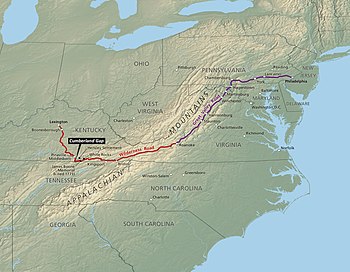Appalachian Mountains: Difference between revisions
Pat Palmer (talk | contribs) mNo edit summary |
Pat Palmer (talk | contribs) (adding a map of the Wilderness Trail leading to Cumberland Gap) |
||
| Line 4: | Line 4: | ||
The '''Appalachian Mountains''' are a chain of mountains found in [[North America]], running parallel to its east coast. While most maps of the Appalachians, from the United States, show the chain's end in [[Maine]] (the most northeastern state in the United States), the mountain chain also extends into [[Quebec]]'s [[Gaspe peninsula]], the western edge of [[New Brunswick, Canada|New Brunswick]], and the western shore of the Island of [[Newfoundland]]. | The '''Appalachian Mountains''' are a chain of mountains found in [[North America]], running parallel to its east coast. While most maps of the Appalachians, from the United States, show the chain's end in [[Maine]] (the most northeastern state in the United States), the mountain chain also extends into [[Quebec]]'s [[Gaspe peninsula]], the western edge of [[New Brunswick, Canada|New Brunswick]], and the western shore of the Island of [[Newfoundland]]. | ||
== How the Appalachians compare to other huge mountain chains == | |||
The chain formed through the collision of continental plates, approximately 500 million years ago. | The chain formed through the collision of continental plates, approximately 500 million years ago. | ||
As an older chain than the [[Rocky Mountains]], and the [[Himalayas]], the Appalachian mountains are generally lower and not as imposing, but the rugged, steep, bunched-up formations, typically at around 5000', formed a barrier to European settlers hoping to move west in the early days of the [[United States of America|United States]]. The highest peak in the chain is Mount Mitchell in North Carolina at 6,684 feet above sea level. | As an older chain than the [[Rocky Mountains]], and the [[Himalayas]], the Appalachian mountains are generally lower and not as imposing, but the rugged, steep, bunched-up formations, typically at around 5000', formed a barrier to European settlers hoping to move west in the early days of the [[United States of America|United States]]. The highest peak in the chain is Mount Mitchell in North Carolina at 6,684 feet above sea level. | ||
For European settlers trying to go west from | == Only one way through for early European settlers == | ||
{{Image|NPS cumberland-gap-wilderness-road-map.jpg|right|350px|The wilderness road leading to Cumberland Gap, the only way to get wagons through the Appalachian mountains in colonial times.}} | |||
For European settlers trying to go west starting anywhere from North Carolina to New Jersey, there were two southwest-to-northeast mountain ridges that had to be crossed: Cumberland Mountain (more westerly) and Pine Mountain (more easterly). There were two gaps across Cumberland Mountain, at either Pennington Gap (Virginia) or, about 40 miles southward, Cumberland Gap. However, there is no easy way across the easterly Pine mountain ridge in the vicinity of Pennington Gap. Thus, Cumberland Gap became the only feasible way through for wagon trains, and in 1775, [[Daniel Boone]] led an expedition to blaze a trail across the [[Cumberland Gap]]. Cumberland Gap became a famous place and also became the meeting point of three states, Tennessee, Virginia, and Kentucky. | |||
Forty years later (and much farther north), a more practical route across the Appalachians was developed when a [[canal]] was built through the [[Mohawk Valley]], across [[New York (U.S. state)|New York State]], to [[Buffalo, New York]], at the eastern tip of [[Lake Erie]]. | Forty years later (and much farther north), a more practical route across the Appalachians was developed when a [[canal]] was built through the [[Mohawk Valley]], across [[New York (U.S. state)|New York State]], to [[Buffalo, New York]], at the eastern tip of [[Lake Erie]]. | ||
Revision as of 13:48, 21 March 2023

The Appalachian Mountains are a chain of mountains found in North America, running parallel to its east coast. While most maps of the Appalachians, from the United States, show the chain's end in Maine (the most northeastern state in the United States), the mountain chain also extends into Quebec's Gaspe peninsula, the western edge of New Brunswick, and the western shore of the Island of Newfoundland.
How the Appalachians compare to other huge mountain chains
The chain formed through the collision of continental plates, approximately 500 million years ago.
As an older chain than the Rocky Mountains, and the Himalayas, the Appalachian mountains are generally lower and not as imposing, but the rugged, steep, bunched-up formations, typically at around 5000', formed a barrier to European settlers hoping to move west in the early days of the United States. The highest peak in the chain is Mount Mitchell in North Carolina at 6,684 feet above sea level.
Only one way through for early European settlers
For European settlers trying to go west starting anywhere from North Carolina to New Jersey, there were two southwest-to-northeast mountain ridges that had to be crossed: Cumberland Mountain (more westerly) and Pine Mountain (more easterly). There were two gaps across Cumberland Mountain, at either Pennington Gap (Virginia) or, about 40 miles southward, Cumberland Gap. However, there is no easy way across the easterly Pine mountain ridge in the vicinity of Pennington Gap. Thus, Cumberland Gap became the only feasible way through for wagon trains, and in 1775, Daniel Boone led an expedition to blaze a trail across the Cumberland Gap. Cumberland Gap became a famous place and also became the meeting point of three states, Tennessee, Virginia, and Kentucky.
Forty years later (and much farther north), a more practical route across the Appalachians was developed when a canal was built through the Mohawk Valley, across New York State, to Buffalo, New York, at the eastern tip of Lake Erie.
